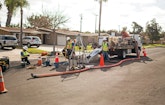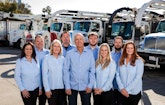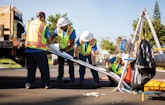Interested in Business?
Get Business articles, news and videos right in your inbox! Sign up now.
Business + Get AlertsThere are many factors that helped Victor Roberts transform his company, Downstream Services, from an upstart sewer cleaning outfit into a $12 million-a-year full-service company with clients throughout Southern California.
But in the end, four major things spurred the company’s emergence as a player in the region’s underground industries: a heavy emphasis on providing specialized services, a strong entrepreneurial spirit, a focus on employee development, and resourcefulness that is exemplified by the custom equipment the company engineers for specific applications.
“More than anything, our success stems from the fact that we’re very diversified,” says Roberts, who spent years running a grading and underground-construction company before selling it and establishing Downstream Services in 2002. “We do just about everything.
“An agency can call us with a problem, and we’ll help them figure it out, whether it’s sewer inspections, maintenance and repairs, or a process problem at a treatment plant,” he continues. “We’ll not only help them design a fix, but actually do the work, too. We can supply supplemental services such as traffic control and patch-paving services. … We even have been asked to provide IT services for a municipality.
“We’ve always done business this way. We take our cues from our clients. The client is always king.”
Furthermore, relying on subcontractors to do portions of projects usually didn’t end well. Roberts says he quickly found that relying on another company usually meant the job wouldn’t be finished on time. “It is important that the success and quality of a project — and the happiness of the client — is in our hands,” he says. “Subcontracting also puts revenue into other companies’ pockets.”
In the end, Roberts determined it was more cost-effective to invest in and engineer various kinds of equipment that enabled the company to present the client with a turnkey project.
Rooted in iron
While Roberts didn’t realize it at the time, his career effectively started in 1974 when his mother bought a skid-steer to use on a horse ranch she’d purchased north of Escondido. Roberts enjoyed using it so much that after graduating from high school in 1978, he started grading house pads. In the early 1980s, he bought a Caterpillar track loader.
Eventually, he bought more and more excavating equipment and formed his own company, Roberts Engineering Contractors, which grew to include more than 60 pieces of heavy equipment and encompass structural concrete work and installation of underground utilities.
Roberts has a strong entrepreneurial drive. “I’m an ADHD kid and proud of it — that’s the short answer. I’ve always been a high-energy person. I barely graduated from high school because I could never sit still. I’m still that way — I like to have my fingers in everything.”
His career arc took a dramatic turn in 1998 when he sold his company. The main reasons were three-fold. The first: Competition was fierce, which made it difficult to sustain good profit margins. Secondly, the industry was vulnerable to cyclical ups and downs. “I was getting equipment weary,” he recalls. “It was a constant battle, so I wanted to get out of the heavy-iron business.”
The third factor: A local nonprofit environmental watchdog group called San Francisco Baykeeper had sued the California Department of Transportation and other agencies for violations of the federal 1972 Clean Water Act related to stormwater pollution. Roberts saw that as an opportunity to establish relationships with municipalities — a more stable client base — to help them comply with federal clean-water standards.
“That’s why we got into the business,” he explains. “I essentially started Downstream Services because this was something I was very interested in — being a part of cleaning up California’s environment. When San Francisco Baykeeper sued Caltrans, we helped them put together their first contract … and started cleaning storm drains.”
Today, many of Downstream Services’ customers are either local municipalities or the federal government. But the company also relies on scheduled maintenance agreements to clean and maintain stormwater sewer systems for big-box retailers and large-scale property management firms. Its primary services are pipeline assessments, systems maintenance, and rehabilitation; underground services (such as UV-cured, glass-reinforced pipe lining, as well as installation of wet utility structures and facilities); and stormwater compliance, flow monitoring, and 24/7 emergency response services.
Resourceful streak
In order to better serve customers, Downstream Services often develops its own equipment and innovative tools to achieve its desired results. “I never want to hear, ‘This is the way we’ve always done it,’” Roberts says. “We’re always looking for more efficient and productive ways of doing things.”
For example, the company frequently fabricates its own cutting tools for its water jetters to perform tasks such as reinstating laterals and pulling rocks from pipelines or handling tough cleaning jobs. “We’ve even used cameras to grab things — attached a wire-basketlike tool to the rotating head on our (R.S. Technical Services Inc. (RST)) cameras,” he says. “They probably don’t want to hear about what we do with their cameras.”
The company also has fashioned its own tires for inspection cameras that allow the tractor to get a better grip when traversing slick biofilms on sewer pipes. “The tires slip, just like your feet do when you’re walking on mossy rocks in a riverbed,” Roberts explains. “But we developed tires that cut through the biofilm.” The company also builds its own dewatering boxes out of roll-off containers — 12 in all.
On a larger scale, the company also fabricated what Roberts calls storm drain filter trucks, used to clean catch basins and storm drains. The company owns five of these trucks, each built out on an Isuzu NRR chassis with an 800-gallon debris tank (also self-fabricated), a 200-gallon water tank, and an 800 cfm blower made by Roots Systems.
“We could never find a truck we really liked, plus they’re expensive,” he explains. “So we make our own.” The company also fabricated its own 4,500-gallon tanker truck equipped with a Jurop/Chandler vacuum pump, a skid-mounted pull-plate cable drain cleaning machine, and two trailer-mounted sewer bucket-cleaning machines.
Where does this do-it-yourself mentality come from? Roberts says it stems back to his days in civil contracting, where contractors are responsible for a multitude of tasks that challenge their ingenuity and resourcefulness. “You just get used to figuring things out,” he says. “Plus, I’m pretty mechanically inclined.
“It’s often difficult for us to find components the way we want them, especially made locally,” he continues. “So it’s natural for us to do things ourselves.”
As such, the company has a 6,000-square-foot light machine shop with a wide array of metal-working equipment, such as a steel-working lathe and welding machines. The company also employs a shop foreman and six shop employees: mechanics, fabricators, and machinists.
“We do all our own maintenance and repairs,” Roberts says. “The cost for that stuff gets crazy, so we do it ourselves. Plus, there’s no real repair facility around here; the closest one is 45 minutes away in San Diego. So it also makes sense economically.”
Large fleet of equipment
Downstream Services also owns many other machines and pieces of equipment, including six Camel waterjetting trucks, built by Super Products on Freightliner chassis with Roots Systems blowers; one trailer jetter made by Harben and two manufactured by Jetters Northwest; an Inuktun Services long-range sonar pipeline inspection camera system; and six CCTV trucks, built out by Downstream Services on Mercedes-Benz Sprinter vans, using RST cameras and technology.
For pipe rehabilitation, the company has invested in a UV-cured, glass-reinforced pipe lining system made by Reline America. In addition, the company’s emphasis on safety is reflected by its use of DBI-SALA confined-space gear (3M) and four self-contained breathing apparatuses — Survivair Sperian Cougar models made by Honeywell Analytics. To manage its small-equipment inventory, Downstream Services’ asset department uses Asset Panda software.
Looking ahead, Roberts says he anticipates further growth for the company, some of it through geographic expansion. Pipe lining also is expected to generate more revenue as demand for that service grows. “Our goal in the next three to five years is to open an office in central or Northern California, where we see a lot of need for our services,” he says. “We expect to hit $20 million in sales within the next five years.”
One thing won’t change, however: Roberts’ work ethic and the client satisfaction the company provides. “We’re old-school here,” he explains. “You don’t get a voicemail when you call here. Even if you call us at 2 a.m., you’ll still get a live person and whoever is on duty that night will call you back. Whatever we do, we do it right.”
Giving employees a career, not just a job
Like so many contractors these days, Downstream Services in Escondido, California, has a hard time finding good, qualified employees. But company officials have found that referrals from current employees makes that daunting task a little easier.
Moreover, the company also employs several strategies to retain employees after they’ve come aboard, says Victor Roberts, owner and vice president of the company. Downstream Services offers a profit-sharing program and pays all employees who’ve been employed for at least one year. The amount of the bonus depends on the current year’s profits.
The company offers employees other perks, ranging from a 401(k) retirement program to health insurance benefits. Such benefits allow it to compete with pensions offered by municipalities, he says.
“We even give employees no-interest loans for things like vehicle breakdowns or medical emergencies,” Roberts says. “We set a cap on these loans, and employees have to be with us for a year in order to qualify. We can either deduct payments from their paychecks or collect the money as they can afford to pay.”
The company also strengthens its employee retention rate by performing regular job reviews. “We diligently let them know what they need to do to improve,” he notes. In the same vein, the company invests in employees by supporting and allowing time for continuing education.
“The state has several different levels of certifications,” Roberts explains. “Each time an employee achieves one, they get an automatic pay bump. Or if a driver gets a commercial driver’s license, that bumps him up $1 an hour, too. Everything they do to better themselves, they get more money.” The company also strives to promote from within, he adds.
“We’re most proud of the fact that we treat employees like family because it’s a family business. I know the name of pretty much every employee we have. To retain them, they need to be happy coming to work every day. We work very hard every day to make sure they’re happy.”











